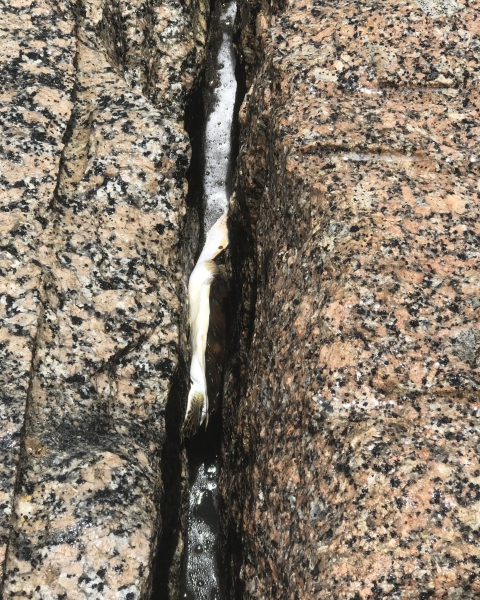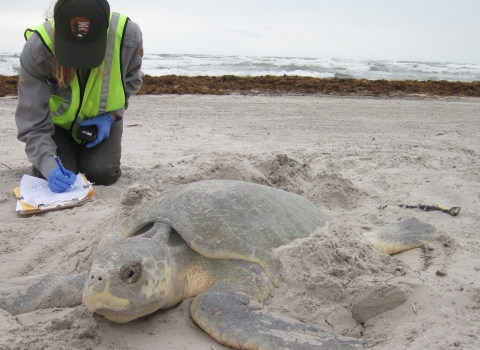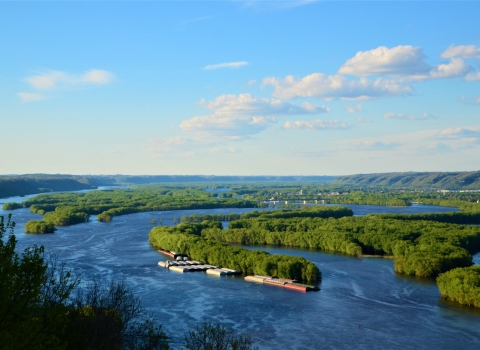Stranding responders and concerned citizens along the Texas coast have reported an increase in juvenile green sea turtles trapped in jetty rocks and washing ashore near these passes. The U.S. Fish and Wildlife Service and local partners urge the public to be vigilant and report sightings of these turtles immediately for proper rescue and care.
“Once a sea turtle is wedged between the rocks, it’s impossible for them to get out without human help,” said Mary Kay Skoruppa, U.S. Fish and Wildlife Service Sea Turtle Coordinator for Texas. “It is important that individuals report them immediately so that trained responders can recover them and take them to a rehabilitation facility for medical treatment. While they may appear healthy, these turtles can develop pneumonia from inhaling water and infections from where the rocks have scraped their shells.”
Green sea turtles are one of five sea turtle species found in the Gulf of Mexico and Texas coastal waters. Juveniles use Texas bay systems as feeding grounds due to the abundant seagrasses. To reach these areas, they swim through channels and passes lined with jetties and feed on algae that grows on the rocks. Unfortunately, strong waves and coastal flooding can cause them to be washed ashore or become trapped in the jetty rocks.
If a sea turtle is seen on a beach, shoreline, or wedged in jetty rocks, it is likely sick, injured, or nesting (depending on the season). The Service advises citizens in Texas to report these sightings immediately by calling 1-866-TURTLE-5 (1-866-887-8535).
When reporting, callers should be prepared to describe the location, the turtle's condition (alive or dead), and its size (estimated weight or shell length – this helps determine the number of responders needed). If possible, callers should stay near the turtle to guide officials and protect it from vehicles or scavengers.
Citizens are advised against interacting with sea turtles directly, including picking up turtles to take pictures with them, removing barnacles, or removing fishing gear. While these actions may be well-intentioned, they could inadvertently harm the turtle, and can be considered a violation of the Endangered Species Act and could be punishable under the law.
“The Service and its partners greatly appreciate the public's assistance in protecting these endangered and threatened creatures,” Skoruppa said. “But while the urge to help a sea turtle might be strong, please refrain from any direct interaction. By reporting injured turtles promptly, you become a valuable part of their rescue and recovery.”
Rescued sea turtles are transported to authorized rehabilitation facilities for medical evaluation and treatment. These facilities, permitted by the Service, meet strict standards for specialized care and have the necessary experience to treat sea turtles. Once medically cleared, the turtles are released back into the wild near known foraging areas.
Organizations and individuals involved with the rescue, transport, medical assessment, and care of stranded sea turtles include Padre Island National Seashore - Division of Sea Turtle Science and Recovery, Texas Parks and Wildlife Department, National Oceanic and Atmospheric Administration (NOAA) Fisheries, Gulf Center for Sea Turtle Research at Texas A&M University in Galveston, Houston Zoo, Mid-Coast Sea Turtle Rescue, Keep Aransas County Beautiful, Amos Rehabilitation Keep, Texas Sealife Center, Texas State Aquarium, Texas Master Naturalists, Sea Turtle Inc., Turtle Island Restoration Network, and many citizens who have reported stranded turtles and assisted with rescues while recreating off the Texas coast.





